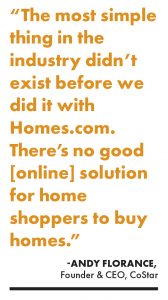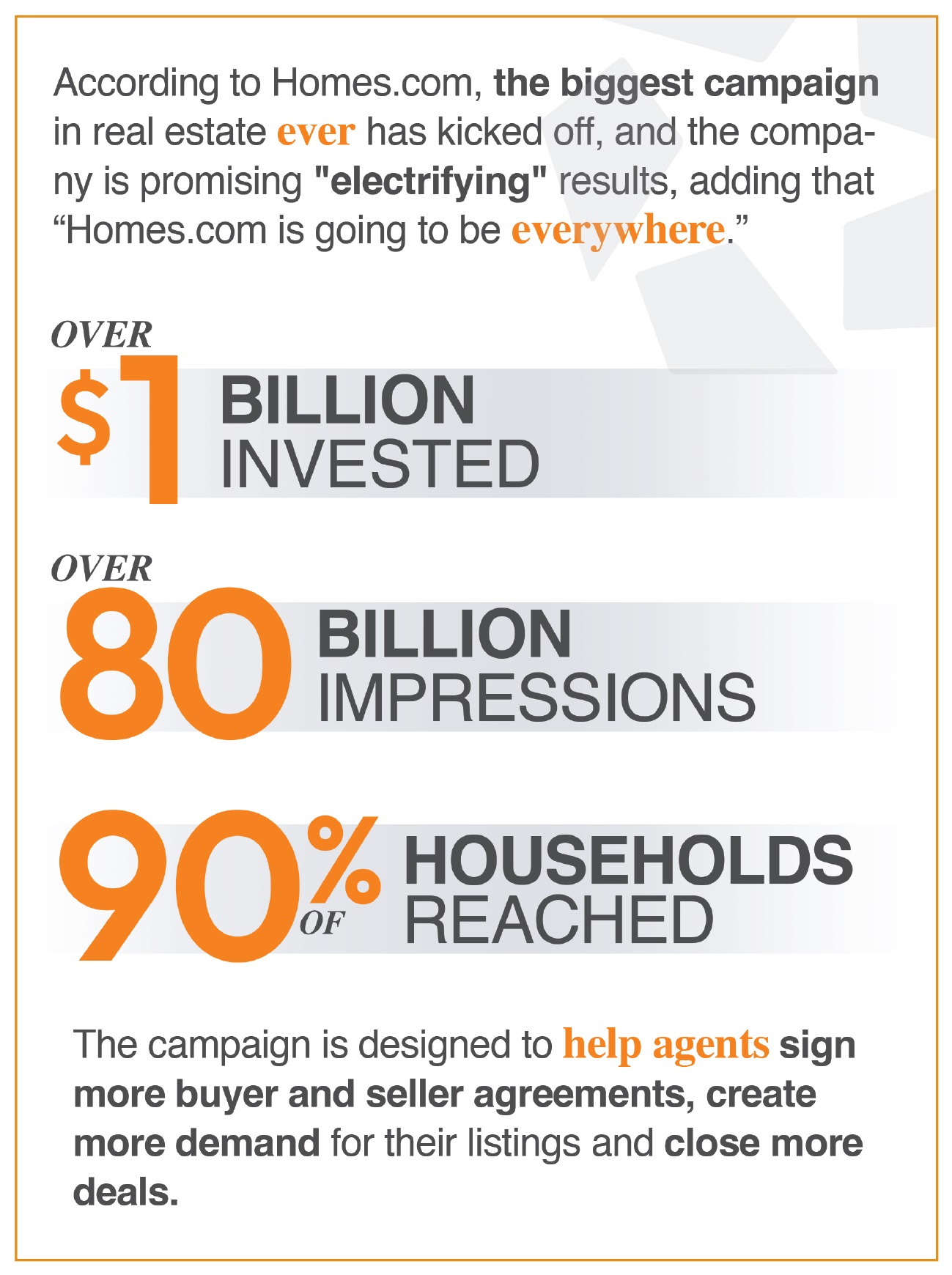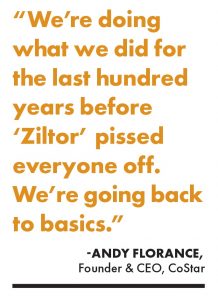The glass booth, transparent except for looping letters spelling out “Homes.com,” sits at the back of what can best be described as a small settlement. Spread across several thousand square feet of the Anaheim Convention Center during the 2023 NAR NXT, the orange glow of the company’s branding shines out from dozens of massive screens, which flash excitedly with slogans, stats and occasionally, an enormous image of Jeff Goldblum, the well-recognized spokesperson for Apartments.com.

CoStar Founder and CEO Andy Florance steps into the glass room. Although the walls are soundproofed powerfully enough to stifle even shouted words, the structure has no ceiling, and so a low rumble of indistinct convention echoes—along with an occasional blast from the PA system—still penetrates the small space.
Florance sits, and behind him—literally and figuratively—is a billion-dollar push into residential real estate, a culmination of more than a decade of methodical, painstaking work. Homes.com, acquired by Florance’s commercial-focused CoStar Group in 2021, is not seeking simply to rival Zillow, Redfin and the other legacy residential portals—it is planning to fundamentally reorient the space, backed by the tremendous capital and clout of CoStar, which also brings a history of dogged, thorough business-building to the sector.
This intended reorientation of the residential real estate portal space kicks off literally and figuratively this month during Super Bowl LVIII, when Homes.com debuts its new multi-million dollar advertising campaign, starring a celebrity spokesperson. It’s just one part of CoStar’s mission to launch the largest marketing campaign the industry has ever seen.
But in this moment, when the industry is shifting fundamentally, and with Homes.com poised to shatter the ranks of portal heavyweights, having already claimed second place last fall with 100 million unique monthly visitors, the foundation, impetus and values of both Florance and his company are under a microscope. Behind the lavish, high-profile marketing push, what is Florance seeking to build—and why?
City on a hill
 In October, when the Burnett verdict was handed down and a cascade of similar lawsuits followed (many angling for damages in the billions), mainstream media—and consumers—finally appeared to take notice. While most of the coverage has focused on the practical and technical changes stemming from these lawsuits, possibly the bigger story is how the industry is perceived, by both consumers and regulators.
In October, when the Burnett verdict was handed down and a cascade of similar lawsuits followed (many angling for damages in the billions), mainstream media—and consumers—finally appeared to take notice. While most of the coverage has focused on the practical and technical changes stemming from these lawsuits, possibly the bigger story is how the industry is perceived, by both consumers and regulators.
In fact, the media coverage itself might count as major fallout from the case, as outlet after outlet has painted real estate with a broad brush, highlighting the most embarrassing moments from the trial and shining a particular spotlight on alleged self-dealing and anti-consumer behavior.
According to Gallup, only 24% of people view real estate agents as having a high level of honesty and ethics (in a poll taken before the Burnett trial). That ranks well above used-car salespeople (10% view that profession as honest), but firmly in the bottom half of professions covered by the prestigious poll.
Florance attributes this popularity problem to what he describes as a spam-ridden, opaque and unfriendly consumer environment created by so-called “legacy” portals. He claims it is actually a bigger issue, based on focus groups and other outreach his company has done.
“If you talk to unrelated friends who are not in the industry, who’ve gone through the home-buying experience—you ask 10, five will say they had a horrible experience,” he says.
Florance compares the current residential real estate climate to how Americans view elected officials. A vast majority of people have a negative view of Congress as a whole, while still supporting their own representatives.
Likewise, most people trust and appreciate their own agents, while often still having a negative view of the industry. Florance describes how often, homebuyers have a “horrific” first impression of agents due to the overwhelming spam they encounter when they reach out or request information via popular portal websites.
 As an experiment shortly before this interview, Florance claims he expressed interest in four homes on the legacy portals using a so-called “burner” phone before dinner. He says he put the phone away, and forgot about it until he realized his jacket had been vibrating nonstop almost the entire time.
As an experiment shortly before this interview, Florance claims he expressed interest in four homes on the legacy portals using a so-called “burner” phone before dinner. He says he put the phone away, and forgot about it until he realized his jacket had been vibrating nonstop almost the entire time.
“I submitted four leads, and got 11 voicemails, 22 calls, 37 texts and 47 emails,” he says, displaying a screenshot of the phone. “It’s still going. Is it 200 now?”
Florance directly blames the other portals’ business model for overall poor public perceptions of real estate, saying that “Ziltor” (seemingly an amalgamation of realtor.com® and Zillow) are responsible for inundating consumers with low-quality junk ads and useless connections to inexperienced buyer agents.
Homes.com has touted a number of ways in which it claims it can improve on the legacy portals. The company has also been explicit in arguing that it is better positioned to ride out potential changes stemming from lawsuits and investigations.
But Florance describes the core position of Homes.com as an attempt to rebuild trust with consumers. With a simple subscription model for agents, a huge emphasis on a fast, functional user experience, and a promise that home shoppers will be connected with the listing agent on a property rather than a plethora of random buyer agents, Homes.com is indisputably taking a different approach than “Ziltor.”
“You’ve got to start by saying, what is the consumer trying to do, and how do you honestly respond to that so that they build a positive relationship with your site?” Florance asks.
He goes further, positing that this approach is fundamentally better for the industry, and urging the National Association of REALTORS® (NAR) and the MLS industry to be “proactive” in pushing back against companies that give real estate a bad reputation.
So far, Zillow and other portal companies have sought mostly to add more, through integrating various affiliated businesses or even homeownership services—things like upkeep, renovation and repair—creating an even larger monolith around the buying and selling experience. Florance says this is fundamentally at odds with Homes.com’s approach.
“The most simple thing in the industry didn’t exist before we did it with Homes.com,” he argues. “There’s no good [online] solution for home shoppers to buy homes. Whether or not you want to try paint samples three years after you buy a home, that’s a minor thing.”
But in another, fundamental way, Homes.com is similar to the other portals. It is still planning on generating revenue from agents, which means consumers are not the customer base—they are the product, similar to how social media companies operate.
When asked how Homes.com plans to prioritize the consumer through this dynamic, Florance calls the question “really important.” He also promises a “really important answer.”
“I think that people have taken it for granted, but it’s a major issue,” he says.
That solution comes back to honesty, he claims. Florance explains that beyond their frustration with spam, consumers are fundamentally confused by how legacy portals operate. It comes down to the way agents are presented, often through a click or a lead-capture form that promises vaguely to help them “contact agent.” Many expect to reach the listing agent, or at least someone who is familiar with the property, but that is often not the case.
“They arrange to go to the home, and at the doorstep of the home, a different REALTOR® answers the door,” Florance describes. “And the consumer says [to their agent], ‘Well who are you? If you’re not the listing agent, who are you?’”
Time will tell whether or not the “your listing, your lead” model can fundamentally alter the relationship between agents and consumers, but Florance is fully committed to the mission as evidenced through Homes.com’s new mega marketing campaign. What’s more, the success of CoStar’s Apartments.com acquisition in 2015 has helped convince shareholders that the company can do the same thing with Homes.com, he says.
“We bought [Apartments.com] doing $75 million in revenue—now it’s approaching a billion,” he says. “That gave us enough credit with our shareholders, I believe, to push them a little bit and say, ‘We believe we can produce a better product for the industry.’”
“And you cannot do this without being prepared to invest a lot,” he adds.
Nuts and bolts
Previous profiles of Florance have mostly focused on his early work with commercial real estate, working out of a Princeton University dorm on an early example of the personal computer, creating his own software—and hardware—in some cases.

That wasn’t the only job he worked in those years, however.
“I washed dishes,” he says. “It was colorful in the kitchen. You could eat the food that people didn’t eat that came back, and so you could eat a lot of good food.”
Tommy Chambers, director of technical services at CoStar, was a fellow dishwasher in those early days, according to Florance.
Florance’s path in life began in residential real estate (he had immediate family practicing both residential and commercial) before turning CoStar into a commercial data giant. He recalls being told by the parents of his then-girlfriend that he needed to get a real job, before the company really got off the ground.
Much has been written about the so-called “CoStar playbook.” Famously, the company built a proprietary database for commercial real estate by making millions of phone calls or sending people to visit over 10 million buildings around the world, a ground game that is largely credited for turning CoStar into a household name (at least in real estate). The plan is to make this same process work for Homes.com.
After all those early years of processing data himself, scrubbing the early internet and compiling public information, along with decades of leading teams to map out millions of multifamily and commercial spaces, how will Florance handle residential?
Or maybe the better question is, why take on yet another immensely difficult, grueling project like this?
“I’ll tell you, it is like filling your own cavities without novocaine,” Florance laughs.
Residential real estate today is also nothing like commercial was in the 1990s and early 2000s. Consumers can easily access reams of data, millions of photos and dozens of other metrics about properties, from school district to weather to disaster risk, from their phone, PC or smart TV. The scarcity of information, which Florance recognized and resolved on the commercial side, simply isn’t an issue in residential today.

But Florance is a firm believer that “proprietary, useful consumer content” is going to propel Homes.com past the competition—partially by focusing on communities rather than individual properties. The company currently has thousands of people traveling the country, over a million drone flights logged and 2 million video clips on the portal as Homes.com builds what is meant to be a huge new database of community-focused info. Besides filming short, high production-value videos, Homes.com’s travel teams are also eating at local restaurants and learning about history and culture at the neighborhood level.
And every two or three years, the company plans to do it all again to ensure all the information is fresh.
Florance says the investment of time, energy and money is tremendous, and the logistics are “mind boggling.”
“But that has continuously allowed us to differentiate ourselves from the competitors and advantage ourselves for consumers,” he says.
From the perspective of the real estate agent, Homes.com’s ambitions are equally lofty, but maybe slightly less grandiose. In the coming months, the company is going to select between 30 and 50 agents in test cities to try out the subscription program for free.
One of the big perception issues Homes.com hopes to solve is how agents approach leads. Florance claims that most agents are so inundated with low-quality leads they often fail to follow up on them, which frustrates consumers and leaves the real estate practitioner unfocused and overwhelmed.
“I’ve purchased 15, 20 companies around the world, and often the ones that are struggling or trying to make ends meet start creating ways to generate 10 leads from an event that was really one lead,” he explains. “And we always collapse it down and take it back to one-to-one.”
Funneling all leads right to the listing agent solves this problem on both ends, Florance claims. “Your listing, your lead” has an obvious appeal from the agent side, and the hope is that real estate companies quickly recognize that what Homes.com will offer is a very different product than competitors. Eventually, agents will value this kind of lead more than the kind that Facebook or “Ziltor” offer—leads generated from a single click or a bit of data, and shared with dozens of agents.
“I don’t think it’s the real estate agency’s fault. I think they’re being rational. I think they’ve been bombarded with low-quality leads,” he says.
Especially in the context of ongoing litigation, this approach seems at least superficially more aligned with a changing industry. Although the portals are not currently the main focus of lawsuits and investigations into real estate, the role of buyer’s agents, and whether they are being artificially propped up by the structures and big players in the industry, has been a key question.
Florance doesn’t avoid talking about the lawsuits, but he also makes no extra effort to address them, or detail where Homes.com sees pitfalls or advantages based on any particular outcome. And while acknowledging critics who fear that Homes.com is “unfriendly” to buyer agents, Florance claims that his platform is actually adhering more closely to the values and historical practice of real estate than competitors.
Harkening back to helping his mother with open houses when he was a teenager, Florance describes what he remembers as a fundamentally more transparent, more smooth and more comprehensive approach to a real estate business—something Homes.com wants to emulate in the online space.
“You had to go to the median and the local street, the busy street with the open house signs on Saturday, Sunday,” he remembers. “That’s the listing agent’s [name] on the home for sale. And it worked, and it was straightforward. The agent with that listing, it meant a lot. They wanted a listing because…it meant they could win more listings in the neighborhood.
“We’re doing what we did for the last hundred years before ‘Ziltor’ pissed everyone off. We’re going back to basics, is what we’re doing.”
For more information, visit https://www.homes.com.




